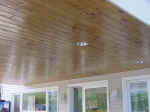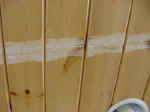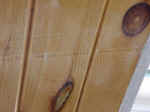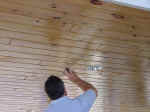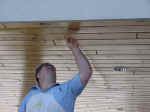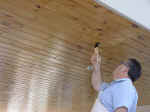Before After
The repair process.
Here are some of the before and after pictures as well as the repair process.
The first few show the damage as it appeared when we inspected it for an estimate.
We were upfront with the owner about not being able to make the damage completely disappear.
With unstained tongue and grove knotty pine and a urethane finish and such deep dents this is impossible to make it so it never happened unless the boards are removed and replaced.
If that were done you still would have variations in the new boards and the old ones and more damage may result to the surrounding areas from the removal of the boards such as damage to the stucco and trim boards.
The replacement could take weeks to accomplish and this would inconvenience both customers and owners.
We have a mobile repair trailer that we set up to meet the needs of many repair circumstances.
Our solution was to first remove the embedded concrete surrounding the dents.
After the grit was removed we were able to steam the dents out. Here we used a small hand held steamer to minimize damage from the steam, most notably blushing. A blush is a white area around the damage, much like what happens under a flower pot on a table when water from the pot has overflowed on to the table.
Some areas required several applications of steam followed by covering the area with a cloth to help hold the heat and moisture in, then repeating the process until the desired results are met or the wood no longer responds to the treatment.
Light sanding the surrounding areas helps lessen the depth but some areas required a "burn-in". Burning in is melting some clear plastic resin to the damaged area to fill it.
Then several light coats of a fast drying urethane -lacquer were applied. Each coat was sanded to both level the area and to match the sheen of the surrounding areas. This was followed by rubbing with a very fine plastic wool pad to lessen scratching.
Finally, the last coat was spread out further than just the dents to blend the repairs and a final rubout.

